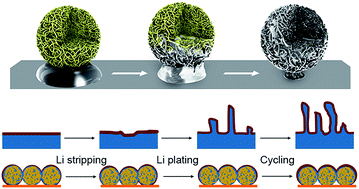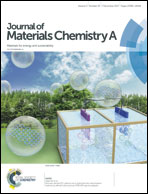A lithium–carbon nanotube composite for stable lithium anodes†
Abstract
Li metal has been considered as the ultimate anode material for high-density electrochemical energy storage technology because of its extremely high specific capacity (3860 mAh g−1), lowest redox potential, and ability to enable battery chemistries with lithium free cathode materials. However, the practical application of Li metal anodes is still prohibited by its low Coulombic efficiency (CE) and growth of Li dendrites during Li dissolution/deposition. Here we report the successful preparation of a lithium carbon nanotube (Li-CNT) composite via a facile and scalable molten impregnation method. When used as an anode material, the Li-CNT composite not only displays the good traits of Li metal such as high specific capacity and low lithium dissolution/deposition potential, but also shows significantly suppressed dendrite formation and high CE. When the Li-CNT composite is paired with a commercial LiFePO4 (LFP) cathode, a CE of around 90.1% can be achieved, which is much higher than the value (75.4%) obtained from a lithium foil anode.

- This article is part of the themed collection: 2017 Journal of Materials Chemistry A HOT Papers


 Please wait while we load your content...
Please wait while we load your content...